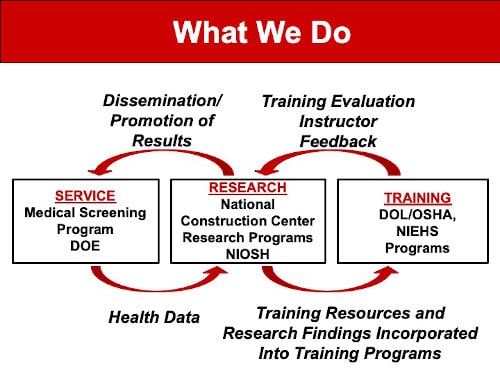Over the past 30 years, CPWR – The Center for Construction Research and Training has planned, developed, and operated a National Center for Construction Safety and Health dedicated to reducing injuries, illnesses, and fatalities in the U.S. construction industry.
A partner with the National Institute for Occupational Safety and Health (NIOSH) since NIOSH launched its construction safety and health research initiative in 1990, we have become recognized world-wide as a leader in the field as a result of having built (1) a multi-disciplinary, integrated research team, (2) outstanding multi-level industry relationships, and (3) an extensive record of major achievements.
CPWR – a nonprofit created by North America’s Building Trades Unions (NABTU) — has the mission, as stated in our Articles of Incorporation, to:
- Encourage the elimination or reduction of conditions constituting hazards to the safety or health of U.S. construction workers, and to promote the maintenance and improvement of safe and healthy working conditions for workers in the construction industry;
- Publicize the results of research findings, and to make them widely available to construction industry owners/users, employers, associations, unions, workers, academia, government, and others with an interest in construction industry safety and health;
- Provide training resources and technical services to apply research findings at the work site and to direct research in defining and addressing issues of importance to workers; and
- Conduct research concerning the quality of working conditions; the social, economic, and psychological factors influencing work organization; the impacts on workers and working conditions of new technologies and industry change; and analyses of corporate and government policies and consensus standards that affect the worksite.
RESEARCH
In 1990 CPWR began a series of cooperative agreements with NIOSH based on a competitive application process, and in 2019 we were awarded our seventh consecutive 5-year agreement to continue as the National Construction Center.
The progression of CPWR’s research since 1990 can be summarized this way:
1990-1994: Define the problem and set a research agenda
1995-1999: Define best practices for the industry
2000-2004: Practical research and dissemination of findings
2005-2009: Intensify targeted research and dissemination
2010-2014: Emphasis on research to practice (r2p)
2015-2019: Safety culture and partnerships
2020-2024: r2p assessment and adoption of best practices
From our beginnings, CPWR has led a consortium of experts at universities, government agencies, unions, and corporations (project owners, contractors, and insurers) to help address the issues and find solutions. In our current funding cycle (2020-2024), collaborating organizations in our research consortium include the University of California, San Francisco, University of Massachusetts Lowell, University of Washington, Virginia Tech, West Virginia University, and Washington University in St. Louis.
TRAINING
In 1999 we began our hazardous waste, safety and health, and minority worker training programs with funding from the National Institute of Environmental Health Sciences (NIEHS), and after 9-11 we added disaster response training. During this period CPWR also became a partner as an OSHA-approved National Resource Center and then created a national training network on behalf of North America’s Building Trades Unions. Today, there are 12 International/National Building Trades Unions in CPWR’s NIEHS training consortium, and over 4,000 instructors qualified nationally to deliver OSHA training courses under CPWR’s NRC umbrella. Taken together, tens of thousands of construction workers are trained annually in the U.S. by CPWR and its consortium partners.
SERVICE
A commitment to service runs through all our work. To support our mission and complement our NIOSH-supported construction safety and health research program, CPWR in 1996 launched the Building Trades National Medical Screening Program<. BTMed, which serves former construction workers at U.S. Department of Energy (DOE) nuclear sites, is now the largest medical examination program for older construction workers ever undertaken in the U.S. and is supported through funding from DOE. We also share our expertise with industry and government organizations to address continuing and emerging hazards.
This graphic shows the synergies that have developed between CPWR’s three major program areas:
With our 30-year track record of performance, today CPWR enjoys a high degree of credibility with the research community, the construction industry, and government, and we have effectively brought these groups together around a common agenda in a number of collaborations and partnerships.
Industry stakeholders now look to CPWR not only as the primary source of safety and health information and resources in construction, but as a leading national coordinating body with proven ability to connect interested and responsible parties. Contractors come to CPWR for technical assistance and support for leading indicator and intervention evaluations; OSHA, other federal agencies, contractors, joint labor-management training funds and other providers use our resources for worker safety and health training and outreach; OSHA and NIOSH have joined with us to form a Research to Practice (r2p) Workgroup and partnered with us to lead the national falls campaign/stand down (stopconstructonfalls.org); we’ve connected NIOSH intramural investigators with our research consortium and industry stakeholders through our annual workshop and seminar; and government agencies in addition to NIOSH, such as DOL, DOE and NIEHS, have joined us on targeted construction safety and health initiatives, such as organization of work, safety culture, front-line supervisor safety and health leadership training, and targeting hard-to-reach populations, such as minorities and small employers, which is an emphasis area in our current research program.